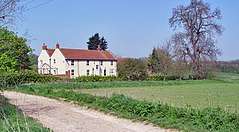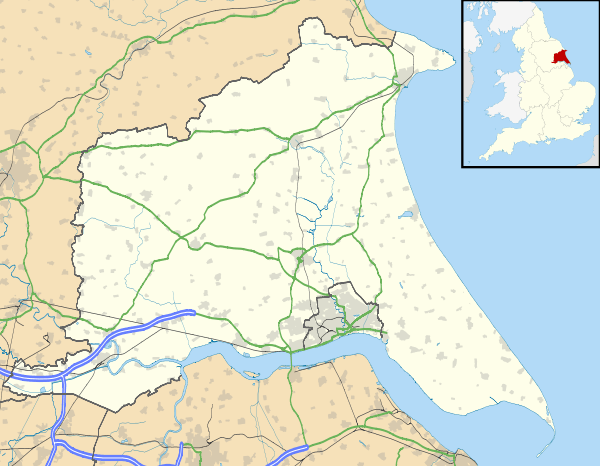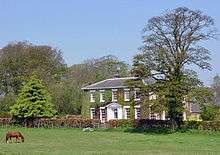Wauldby
Wauldby is a region in the Yorkshire Wolds within the civil parish of Welton in the East Riding of Yorkshire, England. It contains the gentrified hamlet around Wauldby Manor Farm, and a few other minor dwellings including Little Wauldby Farm.
| Wauldby | |
|---|---|
 Cottages at Wauldby | |
 Wauldby Location within the East Riding of Yorkshire | |
| OS grid reference | SE967297 |
| Civil parish | |
| Unitary authority | |
| Ceremonial county | |
| Region | |
| Country | England |
| Sovereign state | United Kingdom |
| Post town | BROUGH |
| Postcode district | HU15 |
| Dialling code | 01482 |
| Police | Humberside |
| Fire | Humberside |
| Ambulance | Yorkshire |
| UK Parliament | |
Wauldby was once the site of a village; the habitation was abandoned in mediaeval times.
Geography
Wauldby is situated approximately 2 miles (3.2 km) north of Welton and 3 miles (4.8 km) west of Willerby. It is within the Yorkshire Wolds beyond the head of Welton Dale, at a height of approximately 330 ft (100 m) with a local high point of 381 ft (116 m). The area is entirely rural; there are two minor dwellings: Little Waulby Farm and Waulby Manor Farm with church, manor house outbuildings and cottages, and a pond Wauldby Dam. Most the land is enclosed field system, there are also minor woods and plantations including the Woodland Trust managed Nut Wood and Wauldby Scrogs.[1]
History
Wauldby was recorded in the 11th century Doomsday survey as "Waldbi", with a population, together with Elloughton, of 36 villeins, 3 smallholders and a priest.[2] The name Waldbi is thought to mean "[place] on the wold", and is Scandinavian in origin.[3][n 1]
The original village was depopulated during the mediaeval period.[5][n 2][n 3] The area underwent enclosure after 1796.[8] In the 1850s the township of Waulby covered 990 acres (400 ha) and contained 49 people.[9]

In 1835 a chapel was built on the site of an older chapel of ease by Anne Raikes the then landowner.[9][10][n 4] It was built in Gothic revival 13th century style, and is thought to be designed by J.L. Pearson.[7][11][n 3]
Wauldby Hall, also known as Waulby Manor, was rebuilt in 1839.[9]
The house was refurbished in the 1960s by Francis Johnson.[13] The church's bell cote was removed in 1980, and both the manor and church building became grade II listed buildings in 1988.[11][14] The house, church and 11.2 acres (4.5 ha) of grounds were put up for sale in 2009 at a price of £1.55 million.[15]
Notes
- Etymology: by meaning farmstead or village.[3] The Old Norse völlr (field), the German wald (wood), and the Anglo Saxon weald are words related to the root of the name.[4]
- "Deserted medieval villages, (1971), M.W. Beresford et al gives a location SE 974297;[6] east of the church, whilst "The Buildings of England: Yorkshire: York and the East Riding, (1972), N. Pevsner" states in a footnote that the site of the deserted village is obvious, and to the south of the Church.[7]
- In Archaeological Journal (1845. vol.1, p.97); Letter from J.L. Pearson: ..there were once some buildings existing at Wauldby ... I built a small chapel somewhere on the site of the old buildings for Mr. Raikes..[12]
- Pevsner's Buildings of England and other sources give a date of building of 1844.[7][11]
References
- Ordnance Survey, 1:25000, 2006
- Wauldby in the Domesday Book. Retrieved 2 December 2012.
- Cameron, Kenneth (1961). English Place Names. B.T. Batsford, reproduced: Redwood Press. p. 80.
- Holderness, Thomas (1881). Some place-names of the east riding of Yorkshire, a paper. p. 16.
- Sources:
- Heaton, Barry. "A History–After The Romans". www.littleweighton.org.uk. Rowley Parish Council. Retrieved 21 February 2012.
.. from aerial photographs we can identify many ancient 'deserted' settlements on the Wolds. Rowley parish has Hunsley, Risby and Riplingham, and Weedley and Wauldby just over our present boundary.
- Harris, Alan (October 1968). "Some maps of deserted medieval villages in the east riding of Yorkshire". Geographische Zeitschrift. Franz Steiner Verlag. 56 (3): 181–193. JSTOR 27816913.
- Heaton, Barry. "A History–After The Romans". www.littleweighton.org.uk. Rowley Parish Council. Retrieved 21 February 2012.
- Beresford, Maurice Warwick; Hurst, John G. (1989) [1971]. Deserted medieval villages: studies. Alan Sutton, orig. Lutterworth Press. p. 209. ISBN 9780862996550.
- Pevsner, Nicholas (1985) [1972]. The Buildings of England: Yorkshire: York and the East Riding. Penguin. Wauldby, p. 361.
- Harris, Alan (1958). "The Lost Village and the Landscape of the Yorkshire Wolds". The Agricultural History Review. 6 (2). Footnote 2, p. 97. JSTOR 40262742.
- Sheahan, J. J.; Whellan, T. (1856). History and topography of the city of York; the Ainsty wapentake; and the East riding of Yorkshire. 2. pp. 541–2.
- Hall, John George (1892). "Wauldby, p.218". A history of South Cave and of other parishes in the East Riding of the county of York. Edwin Ombler.
- Historic England. "Wauldby Chapel (1281448)". National Heritage List for England. Retrieved 21 February 2012.
- Hodson, J.F. (1844). "On the difference of plan alleged to exist between churches of Austin canons and those of monks; and the frequency with which such churches were parochial". In The British Archaeological Association (ed.). The Archaeological journal, Volume 1. Longman, Brown, Green and Longman. North Ferriby Priory Church, p.97. OL 13491210M.
- Churchill, Penny (27 March 2009). "Property in the north of England". Country Life. Retrieved 16 December 2012.
- Historic England. "Manor Farmhouse (1103301)". National Heritage List for England. Retrieved 21 February 2012.
- "Good manors go a long way . . ". This is Hull and East Riding. 19 May 2009. Retrieved 16 December 2012.
Sources
- Gazetteer — A–Z of Towns Villages and Hamlets. East Riding of Yorkshire Council. 2006. p. 11.
External links
| Wikimedia Commons has media related to Wauldby. |
- "Nut Wood & Wauldby Scrogs". The Woodland Trust.
- Burke, John French (1840). "Reports of Select Farms : 6. Wauldby, East Riding of Yorkshire". British husbandry: Reports of select farms, Outlines of Flemish husbandry, Useful and ornamental planning, road making, cottage economy. 3. Baldwin and Cradock.